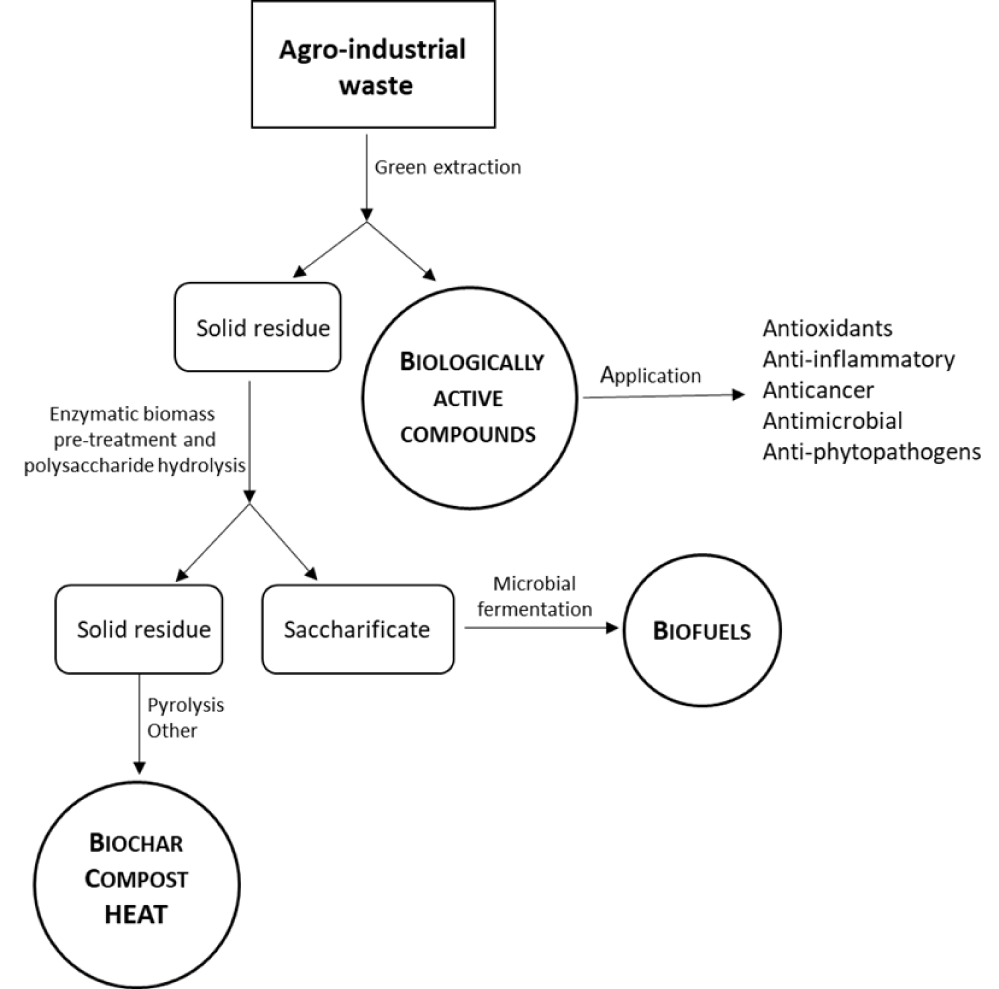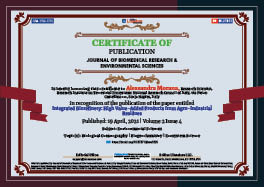> Environmental Sciences. 2021 Apr 19;2(4):286-287. doi: 10.37871/jbres1226.
Integrated Biorefinery: High Value-Added Products from Agro-Industrial Residues
Alessandra Morana*
Every year, the anthropic activities generate thousands of tonnes of agro-industrial residues, which create serious disposal problems and have a very important economic and environmental impact. At this time, the most popular way of their disposing is degradation by biological and/or biochemical and/or thermal treatments; however, they often contain significant percentages of useful compounds that can be extracted and used in several sectors, thus representing an opportunity to be exploited through the development of eco-compatible/sustainable technologies with low environmental impact.
An integrated biorefinery process through which more outputs can be generated from a same waste, such as bioactive molecules, biomaterials and biofuels, represents a promising solution.
One of the main production chains of waste is represented by the agri-food industry. These residues, mostly represented by lignocellulosic biomasses, are attractive and valuable resources able to satisfy the global needs of bio-based products without competing with food sources. Currently, many of them are poorly or not at all exploited, and are burnt as fuel in the industrial plants or used as compost although containing quantities of valuable compounds with multiple uses.
Through the peeling process, the chestnut industry produces a large amount of a solid residue, which represents approximately 10-15% by weight of the chestnut. This fraction is constituted by outer and inner shells, which nowadays are burnt although this practice can create environmental problems because several toxic compounds may be produced, with some of them similar to dioxins (E.g., CO, NOx, long-chain/aromatic hydrocarbons, polychlorodibenzodioxins). According to the chestnut production, 2,005,665 tonnes of chestnuts were produced in the Asian continent in 2018 with China as the major producer (1,849,137 tonnes), and 301,370 tonnes were produced in the European Union-28 where Spain was the manufacturer leader with 188,930 tonnes [1]. Consequently, approximately 200,566-300,850 and 30,137-45,206 tons of shells were generated in Asia and EU-28, respectively.
Despite the abundance of valuable molecules contained in chestnut shells, and the multiplicity of applications that these compounds can have, a real exploitation of this by-product is still scarce.
At present, the most extensive real application of molecules extracted from chestnut shells is represented by the use of tannins in the leather tanning process. Other possible applications remain mainly confined to the scientific literature, such as the use of whole chestnut shells as bio-absorbents for removal of dyes and heavy metals from the wastewater [2].
Outer and inner chestnut shells contain about 36% (w/w) sugars as polysaccharides and 2.7-5.2% (w/w) phenolic compounds well-known for their important properties. Therefore, if subjected to a biorefinery process, such waste can represent an interesting utilizable bioresource until now not fully exploited for eco-sustainable solutions.
According to the scheme depicted in figure 1, a cascading approach can be applied for the production of bioactives, biofuels, and biomaterials. The first step foresees the extraction of biologically active compounds (mainly polyphenols) by means of environmentally friendly methods that avoid or reduce to the minimum the use of organic solvents. Some examples are Microwave-Assisted Extraction (MAE), Ultrasound-Assisted Extraction (UAE), Enzyme-Assisted Extraction (EAE). While MAE and UAE are physical methods based on ultrasounds that cause cell membrane alteration and on microwave energy that breaks the matrix, respectively thus favouring the bioactive compounds release, EAE is based on the use of enzymes that enhance the release of phenolic compounds that are bound to proteins or form a bridge between lignin and hemicellulose.
Then, in the second step, the remaining residue, still rich in polysaccharides is subjected to an enzymatic pre-treatment followed by saccharification of the cellulose and hemicellulose up to fermentable sugars (mainly glucose and xylose). Such sugars will be directly used for production of syrups or for production of biofuels (bioH2, bioethanol), after microbial fermentation of the saccharificate.
In the final and third step, the spent residue, now devoid of useful compounds, can be burnt for heating, pyrolyzed for obtaining biochar to use as adsorbent material, or used as compost.
Whenever possible, a well-planned process providing for the valorisation of residues through an integrated biorefinery scheme leads to the production of multiple products that are all usable and, at the same time, to ZERO WASTE.
The linear economy model must be therefore definitively abandoned for the safeguard of the environment and human health, and all our future actions must be planned in accordance with the concept of circular economy where “when a product reaches its end of life it is reused to create further value”.
References
- FAOSTAT. 15 April 2021. https://bit.ly/3tkONwq
- Ince M, Olcay. An Overview of Adsorption Technique for Heavy Metal Removal from Water/Wastewater: A Critical Review. 2017. Int J Pure Appl Sci. 2017;3(2):10-19. https://bit.ly/3v0vskJ
Content Alerts
SignUp to our
Content alerts.
 This work is licensed under a Creative Commons Attribution 4.0 International License.
This work is licensed under a Creative Commons Attribution 4.0 International License.









